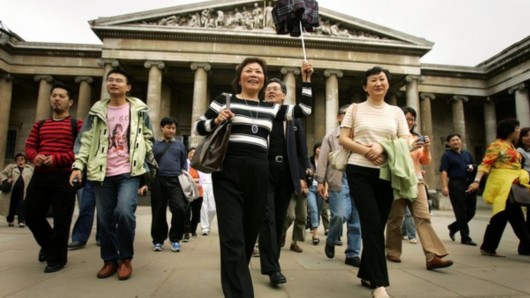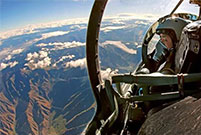


A photo shows a batch of Chinese tourists are travelling in the UK. [Photo: thepaper.cn]
While some greet the Year of Monkey at home with their families, Chen Li is heading for Thailand, expecting to have much more fun than she would by staying home in Shanghai.
"The lunar new year is celebrated across East Asia and Southeast Asia, so experiencing it in a foreign country is something I definitely want my family to try." she said.
Chen and her family will be among 6 million Chinese tourists swarming global destinations during the holiday, 15 percent up from last year.
In 2013, for the first time more than 100 million Chinese took vacations abroad and that number climbed each year.
The World Tourism Organization estimates that 200 million Chinese travellers might go abroad in 2020.
"Countries closer to home, like warmer places in Southeast Asia, are the preferred destinations during the Spring Festival," said Gao Xing of Qunar.com.
Beijing, Shanghai and Guangzhou used to be biggest sources of outbound travellers, with provincial capitals and boomtowns in central and western China catching up fast. There are now direct flights from many of those booming cities to major tourism destinations in the world.
Jiang Jiang, a travel agent in less developed Jiangxi Province, said her outbound travel business doubled in the past couple of years, increasingly fueled by travellers from the heartland.
"We had a record number of people signing up for overseas tours this Spring Festival," she said.
Another reason for an exotic Spring Festival gaining popularity, Jiang said, is that tours to domestic destinations are hardly inexpensive at this time of year, so foreign travels can represent better value for money.
Shopping is an integral part of the Chinese overseas experience and some tours specifically cater for this craving.
Spending overseas has being growing since 2004 and Chinese have replaced Americans as the world's biggest spenders in foreign countries, statistics from the World Tourism Organization showed.
In Japan last year, Chinese travellers splurged 40 percent of the total shelled out by all foreign visitors, the Japan Tourism Agency said. Their per capita spending was roughly 100,000 yen (830 U.S. dollars) more than anyone else's.
While some believe they get better quality when they shop in countries like Japan, price is the factor that gets Chinese travellers' pulses racing.
Luxury items and cosmetics, for example, are less expensive abroad, though that situation is changing as tariffs are slashed at home and duty-free zones open up in domestic destinations.
Retailers in foreign destinations now target Chinese travellers with numerous strategies to loosen their purse strings.
Shopping malls from Florence and Paris to Dubai and Seoul are putting up Chinese language signage and Chinese-speaking sales assistants are in high demand.
The UnionPay bank card has emerged as a mainstream payment option. Chinese credit cards are granted extra discounts in some stores.
Returning home from a recent trip to Japan, Li Fu brought 30 kilograms of cosmetics, watches and home appliances worth 20,000 yuan (3,000 U.S. dollars).
"I bought all these for friends and family," she said.
 Have you ever taken these beautiful subways in China?
Have you ever taken these beautiful subways in China? Chinese beauties, foreign models meet in Chengdu
Chinese beauties, foreign models meet in Chengdu Awesome! Aerial pictures taken on J-11 fighter
Awesome! Aerial pictures taken on J-11 fighter A foreign girl explains what China should be proud of
A foreign girl explains what China should be proud of Chinese navy's air-cushioned landing craft in pictures
Chinese navy's air-cushioned landing craft in pictures Chinese pole dancing master opens class in Tianjin
Chinese pole dancing master opens class in Tianjin Splendid Sichuan after snow
Splendid Sichuan after snow College girl of Vancouver crowned Miss Chinese Int'l 2016
College girl of Vancouver crowned Miss Chinese Int'l 2016 Pentagonal Mart becomes the largest vacant building in Shanghai
Pentagonal Mart becomes the largest vacant building in Shanghai Top 20 hottest women in the world in 2014
Top 20 hottest women in the world in 2014 Top 10 hardest languages to learn
Top 10 hardest languages to learn 10 Chinese female stars with most beautiful faces
10 Chinese female stars with most beautiful faces China’s Top 10 Unique Bridges, Highways and Roads
China’s Top 10 Unique Bridges, Highways and Roads Buying nianhuo!
Buying nianhuo! What Chinese try to sneak on flights (and how)
What Chinese try to sneak on flights (and how) Northeast authorities vow they will work to eradicate GM grains
Northeast authorities vow they will work to eradicate GM grains China’s richest village manages to transition away from old industries
China’s richest village manages to transition away from old industriesDay|Week